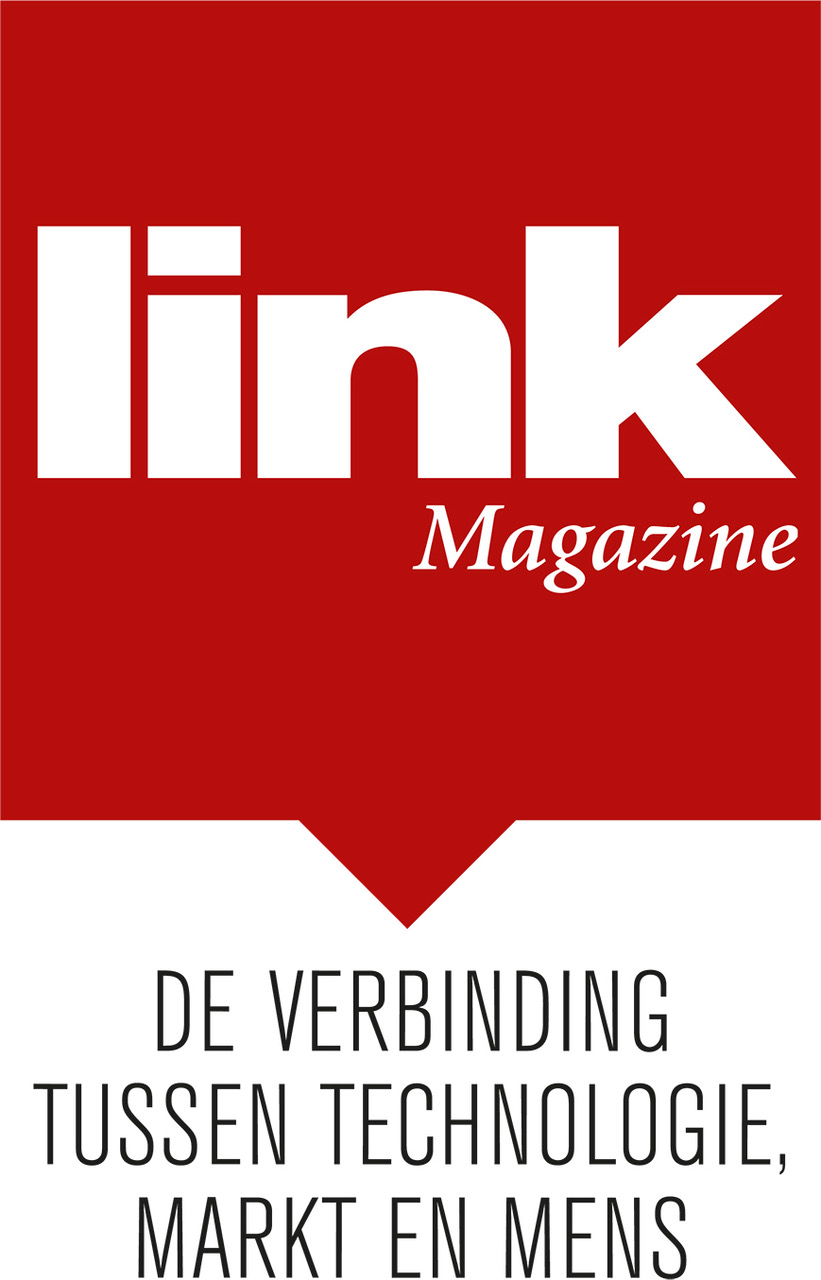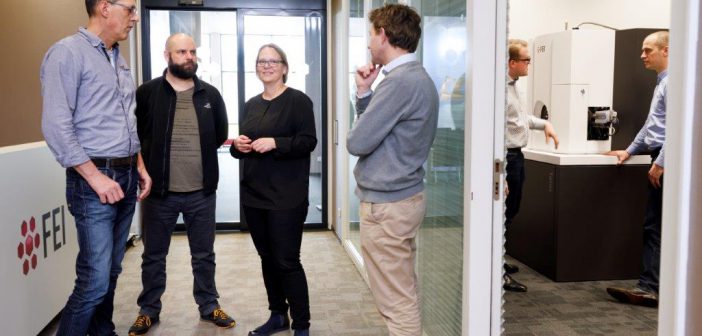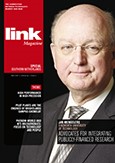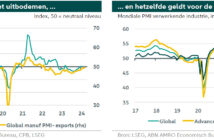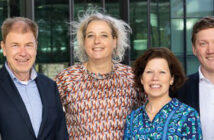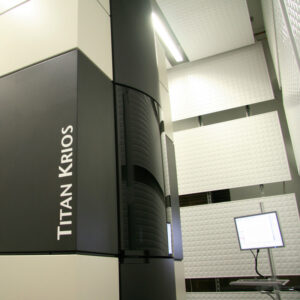
Titan Krios, Foto Fei
The hardware of FEI, part of Thermo Fisher Scientific, is impressive. FEI is the market leader in high-performance electron microscopy, and the biggest device in its range is aptly named the Titan. In engineering the new generation of hardware, the bar is extremely high in terms of beam stability and positioning accuracy. However, the importance of software is increasing and FEI is developing towards becoming a 50/50 hardware/software company, says Senior Director Engineering Brit Meier at the Eindhoven site. “If you really want to offer added value, you need to be good at software.”
Ramping up to an easy-to-use workflow
Since last autumn, FEI – ‘combining hardware and software expertise in electron, ion, and light microscopy with deep application knowledge in the materials science, life sciences, electronics, and natural resources markets’ – has been part of Thermo Fisher Scientific. US-based Thermo Fisher Scientific regards FEI’s electron microscopes as an addition to its own portfolio for scientific instrumentation, in particular the mass spectrometry for life sciences applications. FEI has approximately 2,700 employees worldwide. The three biggest sites are Hillsboro (Oregon, USA), Eindhoven (the Netherlands) and Brno (Czech Republic). In Eindhoven, pre-development (concept development) and engineering are carried out for high-end transmission electron microscopes.
Systems integration
Senior Director Engineering Brit Meier is in charge of approximately 280 employees. “It is my task to enable the team to operate in a multinational environment with strict procedures for product development, while at the same time providing space for the ‘fun & pride’ factor, with local strengths being nurtured and allowed to grow. That is what I learned from working at Philips.” (Meier moved to FEI from Philips four years ago. FEI itself has a Philips history, being in part a successor to Philips Electron Optics, ed.) She sees herself faced with two big challenges. “We always need to be coming up with new ideas, hunting around for new developments with our customers in order to identify what is going to be the ‘next big thing’: we need to understand at an early stage which questions will drive our customers to the research domain.” Meier points to miniaturisation in semiconductors and materials science; for example, the dimensions of semiconductor structures, which are heading towards 10 nanometres or even smaller, in line with Moore’s Law. “The earlier customers like Intel, Samsung and TSMC can discover ever smaller 3-D faults in their wafers using our equipment, the sooner they can fine-tune their processes and the less money they will have to spend on development.” This places high demands on the stability of the electron beam and the positioning of wafers and other samples. For a stable and robust design, FEI needs to bundle together all the relevant disciplines – from electron optics and motion control software to detection and image processing. “Systems integration is our strength.”
Workflow
The second challenge lies in the life sciences market. “Here we are experiencing a steep ramp-up with our Titan Krios for research on proteins and protein complexes. We need to supply each individual customer with the right innovation at the right time and at the right quality. We owe this breakthrough to the decision by Rob Fastenau (former head of FEI in Eindhoven, ed.) to develop cryogenic technology for freezing samples, which enables biological samples to be studied much better. We supply every Titan Krios application-specific and where possible with a complete workflow setting, and we also incorporate solutions by Thermo Fisher Scientific and other vendors. We try to understand the customer’s ‘best known method’ and configure a suitable workflow for it, from preparing samples to processing the analysis data. Biologists want to understand the action of proteins, not play with samples and microscope settings. They want an industrial flow for processing their samples. We support them in configuring that workflow and train them in the use of the Titan Krios. The same applies to semiconductors and materials science. Ultimately, what counts for the user is the value per sample.”
Servitization
So it is logical that FEI should maintain a large service organisation. “We supply capex-intensive equipment and offer the service around it. We want to bind customers to us by meeting their wishes as far as possible (sometimes perhaps too much), by always being available when they have questions and problems and by regularly releasing software updates, etc. We always record the customer’s experiences with our product and what we can improve in a service requirement document, with a focus on serviceability.” However, FEI is not yet presenting itself as an integrated solutions provider. “In semiconductors, for example, we do have employees permanently stationed with customers for service and maintenance, but we don’t second operators the way Thermo Fisher Scientific does in the analysis market.”
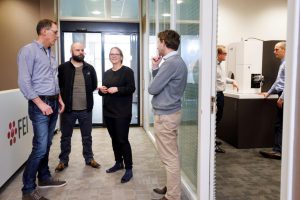
Brit Meier, Senior Director Engineering at FEI, part of Thermo Fisher Scientific, talking to members of her Eindhoven team: “We operate in a multinational environment with strict procedures for product development, and at the same time we nurture our local strengths.” Photo: Bart van Overbeeke
Software and ICT are playing an important role in FEI’s shift towards ‘servitization’. For example, FEI has software and cloud tools to collect information on the equipment at the customer premises. “We can perform online monitoring and remote diagnostics, although that is still a sensitive issue in semiconductors in particular, because all their know-how is wrapped up inside the production recipe. Some customers are afraid that they will lose their intellectual property if we are also supplying their competitors. But the industry is starting to learn how to secure its IP properly. Roughly a third of our customers are already connected to us online. Here in Eindhoven we have a control room where we can call up data and monitor 24/7 if necessary. We look at key parameters, depending on the usage of the equipment; for example, temperature, beam deformation, coil condition, sample positioning performance. We have a service innovation program into which we can input these data in order to learn what we need to improve in subsequent product design.”
Focus on software
Will FEI, part of Thermo Fisher Scientific, become a software company? Brit Meier: “Software without hardware doesn’t do much, and vice versa. The high-tech region here was built on hardware, but software capabilities are clearly increasing. If you really want to offer added value, you need to be good at software. In engineering, we are heading towards fifty percent software. Our customers are getting younger and, in line with the Industry 4.0 trend, what they are looking for is changing. The specific know-how of operators is diminishing, so our user interface needs to be easier to understand. We are all growing towards a digital world, so perhaps in 30 years time we will only be using pictograms.” So everything at FEI is all about easy-to-use workflow. “We have developed an app that can simulate the workflow. The app presents the best known method and, for example, visualises how we can make things easier for customers by having them use the right consumables.”
Software is also crucial for analysing the images made by microscopes. “Depending on the use case and the detection method, customers make their own software for that purpose or get it from FEI or a third-party software supplier. Thanks to an acquisition four years ago, we now have our own Visualization Software Group which supplies software for turning the images into 3-D reconstructions. But if customers want to use special software, we make our system available for that.” Just as hardware-intensive FEI is increasingly opening itself up to software.
